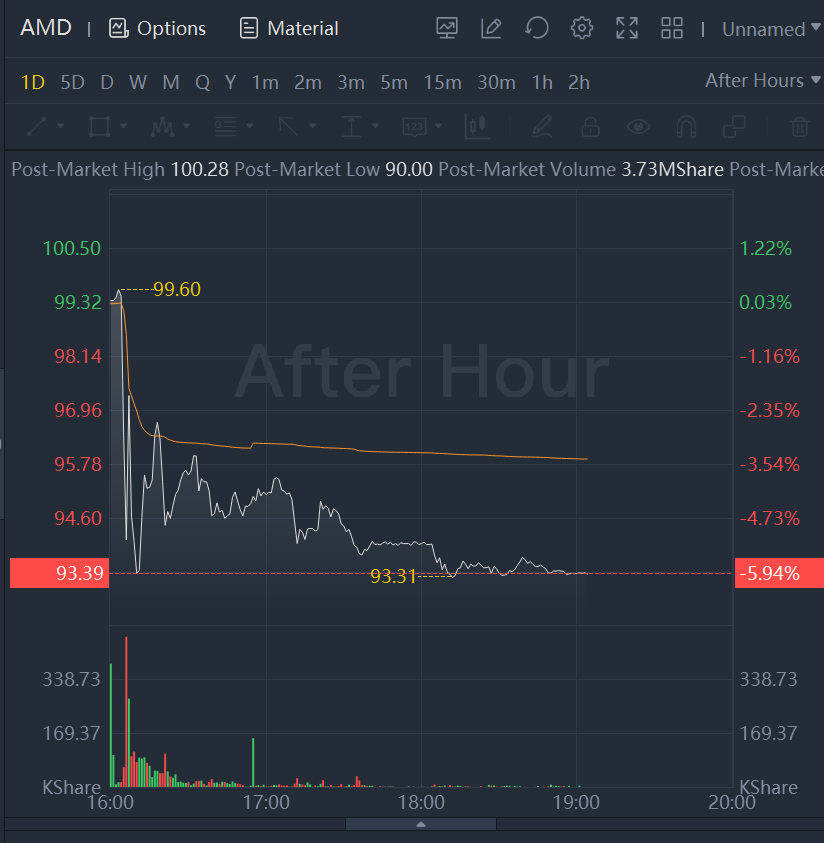- AMD holds firm on annual outlook, sees $6.5 billion to $6.9 billion in current-quarter sales while Street's consensus is $6.84 billion
Advanced Micro Devices Inc. shares declined 5.94% in the extended session Tuesday after the chip maker's revenue forecast fell below the Wall Street consensus after posting record sales, topping Street expectations and reporting a huge surge in data-center sales.
"Despite the current macroeconomic environment, we see continued growth in the back half of the year, highlighted by our next-generation 5-nanometer product shipments and supported by our diversified business model," Su told analysts.
AMD forecast third-quarter revenue of $6.5 billion to $6.9 billion, and restated its revenue forecast of $26 billion to $26.6 billion for the year.
Analysts surveyed by FactSet were estimating revenue of $6.84 billion for the third quarter, and $26.21 billion for the year. The company also backed its gross margin forecast to 54% for the year. Back in February, AMD forecast gross margins of 51% for 2022, and revenue of about $21.5 billion. At that time, Wall Street analysts had a consensus of $19.29 billion in revenue.
Su told analysts on the call that the third-quarter outlook implies data-center sales to lead revenue growth, with PC sales down in the mid-teens. In the fourth quarter, Su said that dynamic should remain but that AMD will be releasing its new 5-nm products in that quarter.
Nanometers, or "nm," denotes the size of each transistor that goes on a computer chip, the general rule being that smaller transistors are faster and more efficient in using power. As AMD moves to its 5-nm chip, Intel has struggled to release its 7-nm chip.
Shares fell 4% after hours, following a 2.6% rise to finish the regular session at $99.29.
In-depth: Are chip stocks set up for a short squeeze, or just more declines? Wall Street doesn't seem sure
AMD $(AMD)$ reported second-quarter net income of $447 million, or 27 cents a share, compared with $710 million, or 58 cents a share, in the year-ago period. Adjusted earnings, which exclude stock-based compensation expenses and other items, were $1.05 a share, compared with 63 cents a share in the year-ago period.
The company reported record revenue for an eighth straight quarter: Revenue surged 70% to a record $6.55 billion from $3.85 billion in the year-ago period.
Analysts surveyed by FactSet had forecast $1.03 a share on revenue of $6.53 billion, based on AMD's forecast of $6.3 billion to $6.7 billion.
AMD reported sales based on new product categories, including breaking out its data-center revenue for the first time. Revenue from data center surged to $1.49 billion from last year's $813 million, a gain of 83%.
Last week, Intel Corp. $(INTC)$reported dismal results and cut its outlook for the year, logging a 16% drop in data-center sales to $4.6 billion and forecasting its data-center sales growing slower than the overall market. In other words, as Intel lost about $900 million in data-center sales, AMD picked up an additional $673 million in data-center sales.
Client sales rose 24% to $2.15 billion from $1.73 billion a year ago; gaming sales rose 32% to $1.66 billion from $1.26 billion; and embedded sales surged to $1.26 billion from $54 million in the year-ago quarter, before the company acquired Xilinx back in February.
In acquiring Xilinx, AMD brought on board so-called field-programmable gate array, or FPGA, chips that can be configured by a customer or a designer after they are made. Those chips are used as accelerators in data centers to boost computing power and improve power efficiency in existing physical spaces.
Adjusted gross margins came in at 54% for the second quarter, up from 48% in the year-ago and first quarters. Meanwhile, rival Intel reported gross margins of 44.8% for the second quarter, and now expects 49% for the year, lower than the 52% to 53% previously forecast by Intel Chief Financial Officer David Zinsner, or "comfortably above 50%" promised by CEO Pat Gelsinger.
Read: The pandemic PC boom is over, but its legacy will live on
Back in June, AMD said at its analyst day it expects average annual revenue growth of about 20% over the next three to four years.
Over the past 12 months, AMD stock has declined 8%. Over the same period, the PHLX Semiconductor Index has fallen 11%, the S&P 500 index has declined 6%, and the tech-heavy Nasdaq Composite Index has dropped 15%.
Elsewhere in the chip sector this earnings season, Texas Instruments Inc.'s $(TXN)$results and outlook topped Wall Street estimates at the time, while Qualcomm Inc.'s $(QCOM)$ outlook fell short because of weakening handset sales.
Chip industry supplier Lam Research Corp. $(LRCX)$topped Wall Street estimates for the quarter and forecast an outlook that was mostly above consensus, while rival KLA Corp. $(KLAC)$ issued an outlook range that was partly below Wall Street estimates at the time Before that, ASML Holding NV (ASML.AE)lowered its revenue forecast for the year after the company said fast orders will push revenue recognition for those sales into next year.
-Wallace Witkowski
$(END)$ Dow Jones Newswires
August 02, 2022 17:36 ET (21:36 GMT)
Copyright (c) 2022 Dow Jones & Company, Inc.
Comments